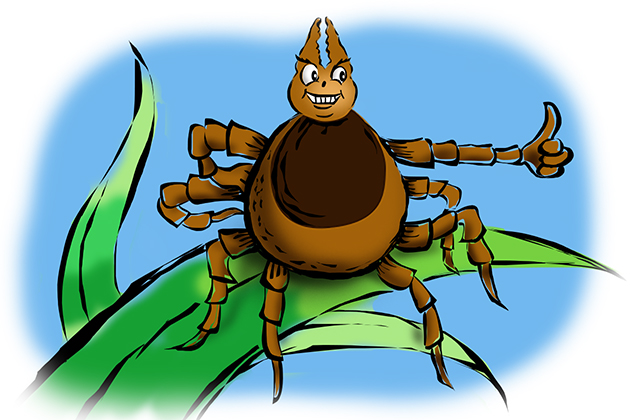Following an unseasonably warm winter, the tick population is flourishing and these shiver-inducing, cringe-worthy arachnids are making themselves known.
To avoid the tiny creatures that are generating news headlines as the carrier of all sorts of diseases, you must have an understanding of ticks’ likes and dislikes. The UConn Home and Garden Center offers a fact sheet about what makes ticks tick.
Thankfully, ticks are unable to fly or jump; but they are particularly good at hitchhiking, using a behavior called “questing.” When questing, the tick clings to the tips of grass or other vegetation with its rear legs, and with its front limbs it will reach out awaiting a passerby and grab hold.
“The ticks are aiming for your head and neck,” says Sandra Bushmich, associate dean of agriculture, health, and natural resources. “Larval ticks will climb about an inch up, nymphs will quest about six inches up, and adults will climb about a foot up on the vegetation waiting for someone to brush by.” After finding their host, they will climb up to find the perfect location for feeding.
Ticks usually feed on different hosts during their various life stages. Larvae often feed on ground-dwelling rodents, while the nymphs and adults search out larger animals including humans.
The hungry ticks literally “dig in” while feeding. They first grasp the skin, cut into it, and insert their feeding tube. It is often difficult to pull off a tick, since some species secrete a cement-like substance that keeps them well attached.
Bushmich also notes that ticks rely on cool, damp, and dark locations, where they hang out so that they don’t dry out. As long as they have somewhere like this to stay, they can go without feeding for months or longer (depending on the species).
The stone walls of New England are not only beautiful, they are also ideal for providing these basic tick necessities. Fortunately for ticks, these habitats are also frequented by small rodents such as squirrels, chipmunks, or mice, who play the dual role of transporting them around and serving as a source of blood for them to feast on.
While the tick hitches a ride and starts chowing down, its rodent host carries on with its life, scurrying about looking for food and making rodent babies. The tick will hang out here until it is full, when it will ditch its current host, molt, and then in its new stage of life search for a different host, whether it be another rodent, a deer, a dog, a human – you name it. There are few places these hitchhikers can’t access.
Since rodents are key players in the tick life cycle, controlling their population is a vital step in reducing the tick population. Cute as they may be, these rodent hosts are typically where the young ticks – the nymphs – are first exposed to diseases such as Lyme, Powassan, or Anaplasmosis. Rodents are reservoirs where these pathogens may hang out waiting for a tick to suck them up and transmit them to a new host. According to the Home and Garden Center’s field rodent fact sheet, populations of small mammals are effectively controlled with baited traps or by keeping cats around to help keep the numbers in check.
Landscape modification also provides a barrier to ticks and can be very effective at management of ticks, says Susan Pelton of the Home and Garden Center.
Dry wood mulch and crushed stone are both good. “Just no fresh mulch or leaf litter – keep that clear!” Pelton says. It’s important to maintain clear paths and also provide a dry mulched perimeter around stone walls, plantings, and in areas close to the forest’s edge. Keep wood piles away from the house, and avoid ground covers like pachysandra because they provide excellent cover for wandering rodents, she adds.
Some 82 percent of deer ticks found in a yard will be around 9 feet from the edge of the nearest wooded area, according to the Home and Garden Center fact sheet.
Discouraging the presence of deer is another proven method to reduce tick numbers, Bushmich notes. “Deer are the host that is best for reproduction in the deer tick life cycle, and the deer population is out of control in this area.”
Fences or repellents can be used, but also avoid planting deer-preferred plants such as hosta, ivy, or rhododendron, which act to invite deer onto your property. The Home and Garden Center offers a list of deer-resistant trees and shrubs.
If you have made the gruesome discovery of a feasting tick, remove it as quickly as possible. Since they may be ‘cemented’ in place, it’s no wonder ticks can be tricky to remove. To effectively remove one, grasp it as close to your skin as you can while applying a steady, firm, upward force to pull the tick off without squeezing its abdomen, which can lead to regurgitation of its stomach contents into the host.
Of course, it’s better not to pick up hitchhikers in the first place.



